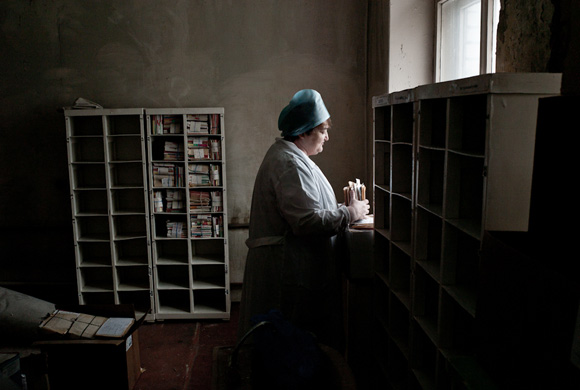In 2011, the World Health Organization (WHO) reported 190,000 new cases of tuberculosis in Russia. This number is 5-8 times the incidence for most other European nations. In addition, many contract TB because they are not being properly treated for HIV/AIDS. Despite the enormity of these figures, the Russian government and media have yet to address tuberculosis as a critical issue in public health. IMR’s Olga Khvostunova spoke to New York photographer Michael Friedman, who recently completed a series documenting the epidemic in Russia and other CIS countries.

© Misha Friedman
"Tuberculosis is a stigma"
Olga Khvostunova: How did you become interested in tuberculosis?
Michael Friedman: I used to work with Doctors Without Borders/Médecins Sans Frontières (MSF). In 2008, they sent me to the Caucasus, namely Ingushetia and Chechnya, as a project coordinator. I was responsible for logistics, security, and organizing construction. The entire medical infrastructure in those areas had been destroyed by two wars. Hospitals lacked medical personnel, and the quality of treatment available was by and large outdated. The tuberculosis program was already in place by the time I had arrived, which is to say that I didn’t choose to work with the disease specifically. However, since I was interested in photography, whenever I had the opportunity, I documented what I saw. An important component in the work of the MSF organization is called témoignage — testimony. Journalists usually work alongside the doctors to gather evidence, take photographs, and document their progress. In the beginning, I was taking pictures for our reports.
OK: How would patients react to being photographed?
MF: We would usually shadow doctors or staff from other NGOs. I would explain to patients that I was not with the press and that I needed the photographs for MSF reports. I would tell them that if they thought that what was happening to them was unjust, their photos could serve to help prevent something like it from happening to others. Naturally, considering the sensitive nature of tuberculosis, I would only take pictures of people who gave their express consent. Especially since TB carries a stigma in the Caucasus.
OK: Is the stigma associated with the disease itself or with its causes?
MF: Most likely with its causes. In Soviet times, the common perception was that the people who suffered from tuberculosis were drug addicts, alcoholics, felons, and the poor. Because of this, many patients are still ashamed to admit that they have TB despite the fact that today, it is prevalent among the general population in Russia, Ukraine, and especially Central Asia and the Caucasus.

© Misha Friedman
OK: Why this region specifically?
MF: A number of factors play a role in this. First of all, infections are most commonly spread within families. In these countries, several generations traditionally share a home, spending a great deal of time together, breathing the same air. Rooms in these houses are usually poorly ventilated. Since tuberculosis is transmitted primarily via airborne droplet nuclei, people living in such close proximity become infected very easily. If an individual’s immune system has been compromised — for example, as the result of malnourishment — they are at a great risk of developing active tuberculosis. After I left the Caucasus, I worked in Uzbekistan. Sometimes it gets so hot there that people put three layers of curtains over their windows and hang carpets on every wall just to keep it slightly cooler inside. People don’t generally open their windows for ventilation. Under these conditions, if one family member gets TB, they end up infecting everyone else. I saw many such tragic cases. For example, a father had gotten ill and infected his daughters. They had died and he was still alive.
OK: What part of Uzbekistan did you work in?
MF: I worked in Nukus, the capital of Karakalpakstan. It is the poorest part of Uzbekistan. The climate is awful. It’s -40C in the winter, and +40C in the summer. There used to be some industry there, but after the Aral Sea shoaled, people lost their jobs. The MSF TB program was launched there 1997.
OK: Were you also working as a project coordinator in Uzbekistan?
MF: No, I went to Uzbekistan as a photographer. I spent two weeks there, photographing full-time.
OK: What were you focusing on?
MF: It is impossible to present a complete portrait of TB, which has such broad consequences. Instead, when tackling the subject, I try to contemplate one aspect at a time. In Uzbekistan, I focused on the effects of the disease’s stigmatization. It carries a much bigger stigma there than in Russia. People are more ashamed of tuberculosis than of, say, HIV. TB is perceived as a horrible disgrace. There was one case, for example, when I made a home visit to a boy alongside MSF psychologists. He had just been discharged from the hospital. He asked us not to come in our car because it had an MSF sticker on it and he was afraid that his neighbors would see. We ended up taking a taxi. This is the kind of stigmatization and subsequent alienation from society that I tried to capture in my photographs. I’m not just showing people getting X-rays and swallowing pills; I try to reveal the emotional side.

